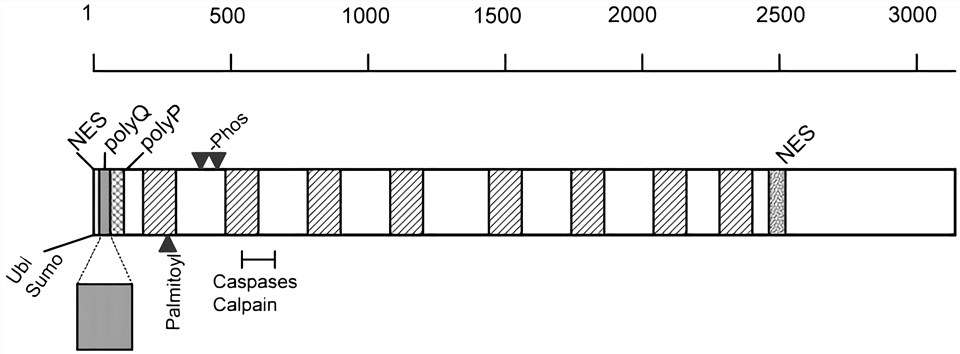Proteolysis targeting chimera (Protein Degraders)-based approaches utilize bifunctional molecules to promote the ubiquitylation and degradation of the target molecule by bringing the target protein and E3 ligase into proximity. One of the indispensable components is the target ligand with high binding affinity. Based on our years of experience in ligand discovery, Creative Biolabs provides comprehensive ligand design services for huntingtin (HTT)-targeting Protein Degraders development.
HTT, a 348 kDa protein found in metazoans, is widely expressed during embryonic development and has a complex and dynamic distribution within cells, with the highest degree of conservation among vertebrates. HTT is predicted to be composed almost exclusively of α-helices, organized into namesake HEAT (HTT, elongation factor 3, protein phosphatase 2A, and the yeast kinase TOR1) repeats. HEAT repeats are thought to be responsible for large-scale conformational changes of the protein as well as alterations in protein-protein interaction networks. The structure of the HTT protein is shown in Fig.1. HTT has Ubiquitination (Ubi), Sumoylation (Sumo) and nuclear export signal (NES) at its N-terminal region, followed by polyglutamine (polyQ) and polyproline (polyP) tract.
 Fig.1 Schematic diagram of HTT protein.1
Fig.1 Schematic diagram of HTT protein.1
Huntington’s Disease (HD) is an autosomal dominant neurodegenerative disorder caused by the accumulation of mutant huntingtin protein (mHTT) containing an N-terminal expanded polyQ tract. The expanded polyQ tract in mHTT forms a β-sheet structure, which causes the formation of fibrillar and nonfibrillar aggregates and mediates aberrant interactions with transcription factors, disrupting the regulation of transcription. HD finally results in a diverse range of behavioral, cognitive and physical symptoms. These symptoms are the results of selective neurodegeneration that occurs preferentially in the striatum. Within brain cells, mHTT is misfolded and forms aggregates with toxic properties. However, the function of HTT, in either the wild type or the HD disease state, is still poorly understood.
Alleviating symptoms of HD through HTT lowering therapies remains an attractive approach for therapeutic development and a major focus area for many HD researchers. Without the complete understanding of the biological function of wildtype HTT protein and mHTT, eradicating HTT protein from the affected tissues in HD patients remains a rational drug discovery strategy. With the continued success of the Protein Degraders technique, Protein Degraders-based approaches for drug design are making headway in HD treatment and represent a new avenue for researchers to explore for HTT lowering therapies.
Since the polyglutamine binding peptide 1 (QBP1) is known to bind an expanded polyQ tract but not the polyQ motif found in normal HTT, QBP1 has become the focus of ligand design for HTT-targeting Protein Degraders. Armed with advanced computer-aided ligand design platforms and rational strategies, Creative Biolabs provides structure-based ligand design service to generate high-quality ligands to HTT targets, including but not limited to engineered antibodies, peptide ligands, small molecule inhibitors. In addition, Creative Biolabs has established different display and screening systems for the identification of peptide ligands that bind tightly to HTT protein.
In view of the progressive and age-dependent nature of HD, targeting HTT protein with the Protein Degraders technique will likely be critical for the efficacy of developed treatment. If you are looking for HTT ligand design or optimization services for further Protein Degraders development, please don’t hesitate to contact us for more information.
Reference
Our customer service representatives are available 24 hours a day, from Monday to Sunday. Contact Us

